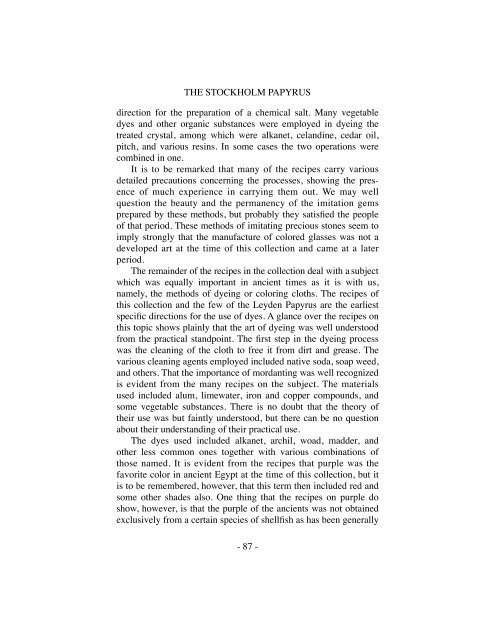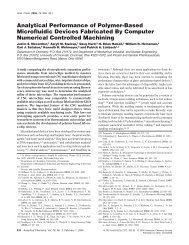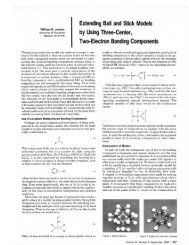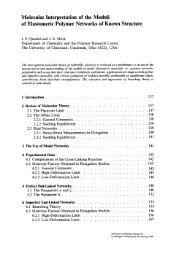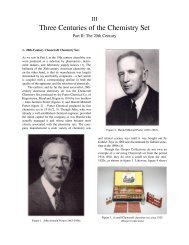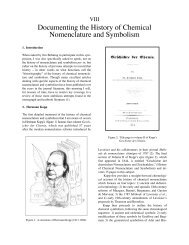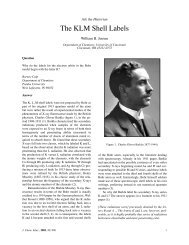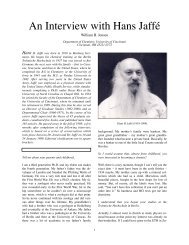The Leyden and Stockholm Papyri - University of Cincinnati
The Leyden and Stockholm Papyri - University of Cincinnati
The Leyden and Stockholm Papyri - University of Cincinnati
You also want an ePaper? Increase the reach of your titles
YUMPU automatically turns print PDFs into web optimized ePapers that Google loves.
THE STOCKHOLM PAPYRUS<br />
direction for the preparation <strong>of</strong> a chemical salt. Many vegetable<br />
dyes <strong>and</strong> other organic substances were employed in dyeing the<br />
treated crystal, among which were alkanet, cel<strong>and</strong>ine, cedar oil,<br />
pitch, <strong>and</strong> various resins. In some cases the two operations were<br />
combined in one.<br />
! It is to be remarked that many <strong>of</strong> the recipes carry various<br />
detailed precautions concerning the processes, showing the presence<br />
<strong>of</strong> much experience in carrying them out. We may well<br />
question the beauty <strong>and</strong> the permanency <strong>of</strong> the imitation gems<br />
prepared by these methods, but probably they satisfied the people<br />
<strong>of</strong> that period. <strong>The</strong>se methods <strong>of</strong> imitating precious stones seem to<br />
imply strongly that the manufacture <strong>of</strong> colored glasses was not a<br />
developed art at the time <strong>of</strong> this collection <strong>and</strong> came at a later<br />
period.<br />
! <strong>The</strong> remainder <strong>of</strong> the recipes in the collection deal with a subject<br />
which was equally important in ancient times as it is with us,<br />
namely, the methods <strong>of</strong> dyeing or coloring cloths. <strong>The</strong> recipes <strong>of</strong><br />
this collection <strong>and</strong> the few <strong>of</strong> the <strong>Leyden</strong> Papyrus are the earliest<br />
specific directions for the use <strong>of</strong> dyes. A glance over the recipes on<br />
this topic shows plainly that the art <strong>of</strong> dyeing was well understood<br />
from the practical st<strong>and</strong>point. <strong>The</strong> first step in the dyeing process<br />
was the cleaning <strong>of</strong> the cloth to free it from dirt <strong>and</strong> grease. <strong>The</strong><br />
various cleaning agents employed included native soda, soap weed,<br />
<strong>and</strong> others. That the importance <strong>of</strong> mordanting was well recognized<br />
is evident from the many recipes on the subject. <strong>The</strong> materials<br />
used included alum, limewater, iron <strong>and</strong> copper compounds, <strong>and</strong><br />
some vegetable substances. <strong>The</strong>re is no doubt that the theory <strong>of</strong><br />
their use was but faintly understood, but there can be no question<br />
about their underst<strong>and</strong>ing <strong>of</strong> their practical use.<br />
! <strong>The</strong> dyes used included alkanet, archil, woad, madder, <strong>and</strong><br />
other less common ones together with various combinations <strong>of</strong><br />
those named. It is evident from the recipes that purple was the<br />
favorite color in ancient Egypt at the time <strong>of</strong> this collection, but it<br />
is to be remembered, however, that this term then included red <strong>and</strong><br />
some other shades also. One thing that the recipes on purple do<br />
show, however, is that the purple <strong>of</strong> the ancients was not obtained<br />
exclusively from a certain species <strong>of</strong> shellfish as has been generally<br />
- 87 -


